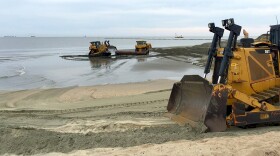A years-long effort to bring the Delaware River shipping channel into the modern era is nearing its last phase.
The Army Corps has been working since 2010 to dredge the channel from 40 down to 45 feet deep. That's the new standard for a port to handle the huge ships that'll transit the newly expanded Panama Canal.
"Once that Panama Canal expansion's done, there'll be some container ships that are larger, that would not be able to use this channel as it is now," says Army Corps spokesman Ed Voigt.
He says Delaware River is the last 40-foot-deep port complex on the East Coast. It's also one of the top-five busiest in the country, moving more than 70 million tons of cargo a year and trafficking almost all the oil for the East Coast. Wilmington, for its part, is the top U.S. importer of bananas.
But Voigt notes that "nobody's claiming that Philadelphia, Wilmington and the other ports are suddenly going to triple their business."
"A lot of it is just keeping these ports competitive," he says. "Keeping pace, keeping the shipments they have now -- probably gaining some new ones as well, but keeping them competitive with the other ports along the Atlantic."
The $364-million dredging project was split into eight contracts. Voigt says the final two are in progress now.
Crews are blasting rocks out of the north part of the riverbed. They'll stop next month and resume next December, to avoid Atlantic sturgeon at their most active in Delaware Bay. That work will then run through March 2017.
Meanwhile, dredging at the mouth of the bay, off Delaware's beaches, will finish this coming April. That's the part of the project that's generated sand to replenish Broadkill Beach. He notes that replenishment didn't suffer serious damage in recent winter storms.
The entire dredging effort is slated to wrap up late next year.
After that, the pressure will be on for ports to take advantage of the new channel depth. Hear more about Wilmington's plans and the challenges ahead -- this Friday at 3 p.m. on The Green.





